
*Editor’s Note: This article was originally published on March 16, 2018, and updated August 31, 2020 with additional information.
Consolidation is a natural part of the evolution of any industry as technologies advance and market expectations grow, and the recession certainly helped to shape the current landscape. Prior to and shortly after the industry downfall in 2008, several companies had formed joint ventures for temporary project development to leverage internal competencies.
Once the market crashed, many smaller businesses found themselves struggling to stay afloat with decreased demand and a saturated market. Mergers with larger companies became the only way to survive for many; this trend has not subsided since then either, with new mergers and acquisitions frequently appearing in the news.
And we could see it increase even more in the coming years as the industry looks for ways to overcome the negative economic impacts caused by the COVID-19 pandemic.
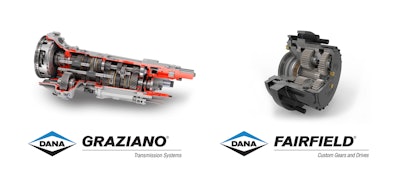 Dana acquired the Drive Systems segment of the Oerlikon Group in 2019, expanding its product portfolio and global market presence.Dana Inc.
Dana acquired the Drive Systems segment of the Oerlikon Group in 2019, expanding its product portfolio and global market presence.Dana Inc.
Why companies merge
There are several reasons that a company would make the strategic move to acquire another company, ranging from product portfolio supplementation, to regional expansion, to technological gains. “In order to be a major competitor in this market, acquisition has to be a part of the business strategy,” says Jonas Worm Hansen, Director of Strategic Development, Danfoss Power Solutions.
“OEMs are looking to achieve greater economies of scale through high-volume production, which places pressure on suppliers to quickly increase their manufacturing capacity,” explains Jeroen Decleer, Vice President of Global Off-Highway Sales, Product Planning and Strategy for Dana Inc. “Selecting a single supplier to manage the consolidation of advanced technologies helps OEMs shorten the vehicle integration process.”
In order to meet the customer’s evolving expectations, such as total system solutions and integration of advanced technologies, the supplier likely has to be larger scale with several vertically integrated technological expertise or competencies. “Demand across off-highway markets continues to increase, and advanced technology is playing a growing role in supporting stricter emissions regulations and leading-edge vehicle functions, such as autonomous driving, hybridization and electrification, and vehicle intelligence,” says Decleer. “The growing prevalence of global vehicle platforms is also playing a significant role.
“To address these trends on behalf of OEMs, suppliers must make a substantial investment in engineering capabilities, manufacturing capacity, and global footprint. Consolidation and joint venture relationships have helped us to scale up our capabilities [at Dana] in these areas quickly and effectively,” Decleer says.
“Really, you need financial power, a global footprint and the ability to scale production according to market need. These are all things that are difficult for smaller companies to provide on their own,” says Hansen. “Furthermore, to act on emerging market trends — like digitalization or connectivity — you need to be able to invest the time and resources to capture valuable insights. These investments are usually significant in size, which is also difficult for smaller manufacturers, further driving consolidation.”
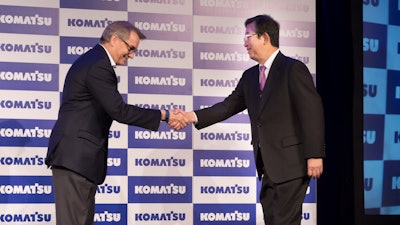 Komatsu Mining Corp. President and CEO Jeffrey Dawes (left) shakes hands with Komatsu Ltd. President and CEO Tetsuji Ohashi upon the completed rebranding of Joy Global after it was acquired by Komatsu.Komatsu Mining Corp.
Komatsu Mining Corp. President and CEO Jeffrey Dawes (left) shakes hands with Komatsu Ltd. President and CEO Tetsuji Ohashi upon the completed rebranding of Joy Global after it was acquired by Komatsu.Komatsu Mining Corp.
READ MORE: Company Merger aims to Expand Value for Mining Customers
Martin Nordborg, Director of Integration Management at Danfoss Power Solutions, cites the increasing OEM demand for automotive-grade expectations as another key contributor to resource-driven acquisitions. “We see a lot of customers in agriculture and construction, for example, putting the same demands on their products as they do in the automotive industry. These include quality assurance and certifications. And considering the legwork required to be able to provide those automotive standards to the off-highway industry, it’s very difficult to provide without the proper resources.”
And beyond taking advantage of emerging trends and technologies, off-highway machinery in and of itself is simply increasing in complexity and specialization for the customer’s needs. With the lower volumes of off-highway vehicle production paired with the even lower volume of a specialized vehicle application, it is larger, stronger suppliers that are able to take advantage of internal synergies between their engineering, manufacturing and aftermarket teams to offer the OEM customer advanced solutions at a competitive price and delivery time.
Technology advancements drive the need for partnerships
Enhancing a company’s technological capabilities is one of the biggest drivers for industry consolidation, these days especially as electrification and automation development efforts have greatly increased. By merging with another company that already has expertise with a particular technology, development time can be reduced, and new products can be brought to market faster.
Companies like Cummins, Deutz and Dana have been acquiring or partnering with battery manufacturers and other electronic component suppliers to expand their electrification product lines. As these companies have been in the business of more traditionally powered components for much of their existence, adding new expertise enables them to better expand and adapt to changing industry trends. They are also able to bring their industry expertise to ensure these new technologies fit the needs of the heavy-duty equipment industries.
This was the case when CNH Industrial announced it would partner with and take a strategic stake in Nikola Corp. Through the partnership, IVECO and FPT Industrial, the commercial vehicle and powertrain brands of CNH Industrial, will assist in engineering and manufacturing expertise to industrialize Nikola’s fuel-cell and battery electric trucks. The companies will work together to bring these zero-emission vehicles to the North American and European markets. “By bringing CNH Industrial on board, we now have access to manufacturing know-how, purchasing power, validated truck parts, plant engineering and much more,” said Trevor Milton, Chief Executive Officer, Nikola Corporation, in the press release announcing the partnership.
Since then, Nikola has announced several other industry partnerships to accelerate development and market entry of its hydrogen fuel cell powered trucks. “Our motto is if you’re going to fail, fail fast, and learn from it,” said Varoujan Sarkissian, Head of Electrical and Controls Systems at Nikola Corp., during a webinar about Nikola’s partnership with TE Connectivity. He went on to say that the best way to accomplish this goal is by partnering with other companies which have already gone through a similar development process and advanced their technologies for use in the market.
Read more: Nikola Forms Industry Partnerships to Advance Truck Designs
“We are moving fast in the area[s] of autonomous driving and new drive systems,” said Wolf-Henning Scheider, CEO of ZF Friedrichshafen AG, when the company announced in 2019 it was acquiring WABCO. Bringing WABCO’s expertise together with ZF’s will help accelerate development of autonomous vehicle systems, the company said. While the companies have many complementary products, WABCO also brought with it braking technology which will be a new addition and integral part of autonomous system development.
“The positive thing is that WABCO and ZF's portfolios are largely complimentary, and there's also a strong sense of shared values among the two companies and their workforces,” Scheider went on to say. “We have already a long history of successful collaboration. In the past we have developed innovative technologies together and in the future that will help us to a speedy and seamless integration of the companies.”
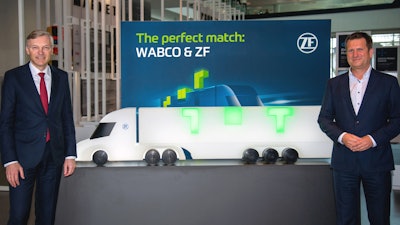 Wolf-Henning Scheider, CEO of ZF Friedrichshafen AG (left), and Fredrik Staedtler (right), who will lead the Commercial Vehicle Control Systems Division.ZF Friedrichshafen AG
Wolf-Henning Scheider, CEO of ZF Friedrichshafen AG (left), and Fredrik Staedtler (right), who will lead the Commercial Vehicle Control Systems Division.ZF Friedrichshafen AG
Read more: Acquisition Brings Technological Advantages
One of the biggest mergers announced in 2020 was Danfoss’ acquisition of Eaton’s Hydraulics Business. The business will be transferred into the existing Danfoss business segment, Danfoss Power Solutions, adding approximately 11,000 employees and 2019 sales of 2.2 billion USD (2.0 billion EUR) to the business segment, which will double the hydraulics business. Through the acquisition the companies will be able to bring together their years of hydraulics expertise to better serve customers. In addition, Danfoss will now have a presence in the industrial hydraulics market.
“Hydraulics is our core, and we have for years strengthened our Power Solutions business through high customer focus, as well as through significant investments in technology leadership. I believe our customers will benefit from combining these two businesses into a full-line hydraulics player dedicated to innovation and with a broad offering of products, robust distribution channels and tremendous geographic reach,” said Eric Alström, President of Danfoss Power Solutions, in the press release announcing the acquisition.
Danfoss’ Hansen says, “Technology trends play a large role in [industry consolidation] – as products become more and more complex, it requires certain sets of expertise, which will inevitably drive more consolidation in the off-highway industry.”
Benefits and challenges
As the heavy-duty vehicle industry has slowly shrunk – both on the whole goods’ side and more significantly on the suppliers’ side – there are positives and negatives to contend with. What does this mean to manufacturers and customers in the on- and off-highway spaces?
According to Nordborg, as suppliers continue to grow in scale, it becomes “a balancing act for OEMs — you don’t want to be too much or too little of a supplier’s business. If you’re more than 10% of a company’s business, you have a tremendous influence on the survival of a supplier. However, if you’re too small of a company at a large supplier, you may not get the attention you need.”
It is also important that OEMs continue to demand their supplier base remain nimble and responsive to the rapidly evolving market trends, especially in the development of advanced technologies, says Decleer. “Suppliers must maintain an entrepreneurial orientation to produce the innovations that will support autonomous driving, connectivity, electrification and hybridization, vehicle intelligence, and other trends.”
But, there are “definitely more benefits than disadvantages for OEM customers when it comes to consolidation,” claims Hansen. As suppliers grow and can be more self-reliant for solution creation, they also gain the ability to help OEM customers to navigate market conditions and provide higher volumes without as much challenge or delay.
A consolidated supplier base can mean improved efficiency of the global supply chain management, as well as create a one-stop-shop for optimized systems versus individual components. Take Danfoss’ acquisition of White Drive Products in 2016 as an example. Danfoss was strong in orbital motors in Europe, but not in the North American or Chinese markets where White Drives thrived. Acquiring the company meant an expanded market share as well as gaining a manufacturing footprint in North America and China for localized production and engineering support, key benefits to OEM customers.
The larger suppliers also often have more disposable investment funds for continually improving its products, processes and resources.
“Consolidation helps solve a common paradox for OEM customers. They need to deliver quality at a low cost, which requires high volume. At the same time, they need to provide their customers with unique solutions in order to stand out from the competition. To do this, OEMs need to come up with a platform-based design to provide customization, as a value to the individual, but at a high volume. This is where large suppliers like Danfoss come in handy, as we are better equipped to navigate that line,” explains Nordborg.
“I believe that trends in consolidation will continue in our industry — especially in regards to technology. It’s becoming increasingly important for both OEM customers and end-users, and is a key focus area for the off-highway market. Therefore, I expect a lot of investments in technology in the coming years,” says Hansen.
“There are a lot of startup companies that specialize in these technologies. And as larger suppliers look to stay abreast of fast-paced changes, acquiring a smaller startup who has already developed the software is a smart investment,” he says.
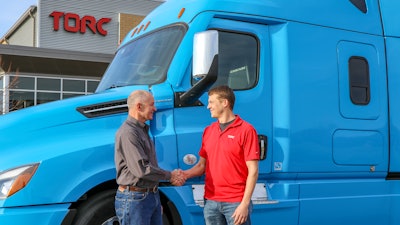 Roger Nielsen, CEO of Daimler Trucks North America LLC, (left) and Michael Fleming, CEO of Torc Robotics, celebrate the new partnership between their two companies.Daimler Trucks North America
Roger Nielsen, CEO of Daimler Trucks North America LLC, (left) and Michael Fleming, CEO of Torc Robotics, celebrate the new partnership between their two companies.Daimler Trucks North America
Nordborg agrees, “I predict that investments in technology will be more of a factor in driving acquisitions and consolidation in coming years. Scaled acquisitions are tough — they require a lot of resources to properly integrate a new company. However, on the technology side of things, acquiring a smaller company who already has the technology can save larger suppliers years and years of development. What they can offer is scaled development, making them ideal partners for smaller, newer businesses.”
In the end, OEMs are looking for their supplier partners to help them address the complex technological challenges in the industry including vehicle autonomy and connectivity, system electrification and hybridization, and overall vehicle intelligence. Acquisitions and mergers allow suppliers to grow and gain technology, resources and capabilities in a more holistic view of vehicle operation and, as such, provide the OEM client with the perspective and market insights it needs to create a superior vehicle.






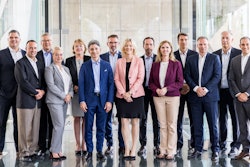
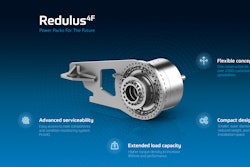


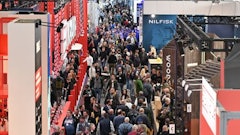


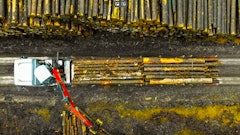

![Hcm Ax Landcros Press Release[32] jpg](https://img.oemoffhighway.com/mindful/acbm/workspaces/default/uploads/2025/11/hcmaxlandcros-press-release32jpg.mAEgsolr89.jpg?ar=16%3A9&auto=format%2Ccompress&fit=crop&h=135&q=70&w=240)



